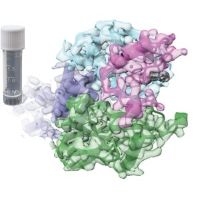Specification
| Organism | Homo sapiens (Human) |
| Expression Host | E.coli |
| Tag Info | N-terminal 6xHis-SUMO-tagged |
| Purity | Greater than 85% by SDS-PAGE |
| Uniprot ID | P15336 |
| Gene Names | ATF2 |
| Alternative Names | Activating transcription factor 2;Cyclic AMP-responsive element-binding protein 2 ;CREB-2 ;cAMP response element-binding protein CRE-BP1 |
| Expression Region | Full Length(1-505aa ) |
| Molecular Weight | 70.5 kDa |
| Protein Sequence | MKFKLHVNSARQYKDLWNMSDDKPFLCTAPGCGQRFTNEDHLAVHKHKHEMTLKFGPARNDSVIVADQTPTPTRFLKNCEEVGLFNELASPFENEFKKASEDDIKKMPLDLSPLATPIIRSKIEEPSVVETTHQDSPLPHPESTTSDEKEVPLAQTAQPTSAIVRPASLQVPNVLLTSSDSSVIIQQAVPSPTSSTVITQAPSSNRPIVPVPGPFPLLLHLPNGQTMPVAIPASITSSNVHVPAAVPLVRPVTMVPSVPGIPGPSSPQPVQSEAKMRLKAALTQQHPPVTNGDTVKGHGSGLVRTQSEESRPQSLQQPATSTTETPASPAHTTPQTQSTSGRRRRAANEDPDEKRRKFLERNRAAASRCRQKRKVWVQSLEKKAEDLSSLNGQLQSEVTLLRNEVAQLKQLLLAHKDCPVTAMQKKSGYHTADKDDSSEDISVPSSPHTEAIQHSSVSTSNGVSSTSKAEAVATSVLTQMADQSTEPALSQIVMAPSSQSQPSGS |
| Form | Liquid or Lyophilization |
| Buffer | The default storage buffer is Tris/PBS-based buffer, 5%-50% glycerol if the delivery form is liquid. The lyophilization buffer is Tris/PBS-based buffer, 6% Trehalose, pH 8.0 if the delivery form is lyophilized powder. Please contact us if you have any special requirment. |
| Reconstitution | Please reconstitute protein in deionized sterile water and we recommend that briefly centrifuge thevial prior to opening the vial .We recommend aliquot for long-term storage at -20℃/-80℃. |
Background
| Relevance | Transcriptional activator which regulates the transcription of various genes, including those involved in anti-apoptosis, cell growth, and DNA damage response. Dependent on its binding partner, binds to CRE (cAMP response elent) consensus sequences (5'-TGACGTCA-3') or to AP-1 (activator protein 1) consensus sequences (5'-TGACTCA-3'). In the nucleus, contributes to global transcription and the DNA damage response, in addition to specific transcriptional activities that are related to cell development, proliferation and death. In the cytoplasm, interacts with and perturbs HK1- and VDAC1-containing complexes at the mitochondrial outer mbrane, thereby impairing mitochondrial mbrane potential, inducing mitochondrial leakage and promoting cell death. The phosphorylated form (mediated by ATM) plays a role in the DNA damage response and is involved in the ionizing radiation (IR)-induced S phase checkpoint control and in the recruitment of the MRN complex into the IR-induced foci (IRIF). Exhibits histone acetyltransferase (HAT) activity which specifically acetylates histones H2B and H4 in vitro. In concert with CUL3 and RBX1, promotes the degradation of KAT5 thereby attenuating its ability to acetylate and activate ATM. Can elicit oncogenic or tumor suppressor activities depending on the tissue or cell type. |
| Involvement in Disease | |
| Subcellular Location | Nucleus, Cytoplasm, Mitochondrion outer membrane |
| Protein Families | BZIP family, ATF subfamily |
| Tissue Specificity | ATF2 |
QC Data
| Note | Please contact us for QC Data |
| Product Image (Reference Only) |  |

